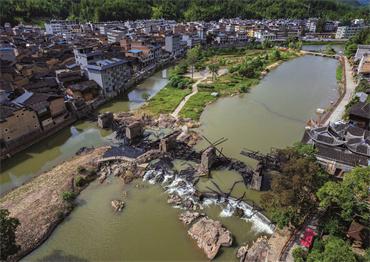Restoration is easy technically. But the collapse triggered a heated debate on whether a structure remains historically valuable if it is rebuilt after complete destruction, and how ancient wooden bridges, which have been overlooked in terms of cultural heritage, should be better protected.
The earliest record of Wan’an Bridge was found in a chronicle compiled in the late Ming Dynasty (1368-1644). According to historical records, the bridge was first built in 1091 during China’s Northern Song Dynasty (960-1127). An inscribed tablet wedged in the stone-made central pier reads the name Jiang Zhen, who funded its construction to honor the wishes of his dead parents and pray for the safety of his family and himself. Prominent families and other local people would donate funds to build bridges and roads as important transportation infrastructure and public space. According to feng shui, or geomancy, a bridge built upstream from a village should lock in water, preventing money from being swept away, while a bridge downstream prevents disaster. Since ancient times, Chinese people believed that donating money to build roads and bridges shows a kind heart and brings them good luck. Today, residents still raise money for new bridges, but not to restore old ones, Chinese media reported.
The bridge earned the name Wan’an, which means “universal peace,” when a craftsman who was working on its restoration in 1932 allegedly fell off into the river below. He apparently survived to tell the tale. Before that, it was called Rainbow Bridge, although locals always referred to it as Long Bridge – the nearby town and village are both called Changqiao (Long Bridge).
There are only 120 wooden arcade bridges in China now, and most are in the mountains and valleys across Zhejiang and Fujian provinces. The six oldest bridges, including Wan’an, can trace their origins to the early Song Dynasty (960-1279). Their styles are similar to the humpbacked Rainbow Bridge, depicted in the famous ancient scroll painting Along the River During the Qingming Festival attributed to artist Zhang Zeduan (1085-1145) of the Northern Song Dynasty. The original is a national treasure kept in the collection of Beijing’s Palace Museum, although copies were made during later dynasties.
The painting depicts a bustling river scene in the Song capital, present-day Kaifeng, Henan Province, during a festival. The single-arch bridge soars across the river, with vendors selling their wares from stalls along both sides of the bustling span. Many thought the bridge had to come from the artist’s imagination, and could not possibly have been real.
It is possible the bridge in the painting, if it existed, was the zenith of woodenbridge building in the Song Dynasty, and the last of its kind. Some Chinese bridge construction experts set out to find how the bridge could have been built, and if there were any early examples of other bridges that still displayed such craftmanship.
In 1953, when the original painting was first publicly displayed, a young bridge architect called Tang Huancheng was stunned by the beauty of the Rainbow Bridge. The bridge is described in “The Reminiscence of the Eastern Capital,” an essay written in the Southern Song Dynasty as: “The bridge, constituting colossal wood planks with no pillars for support, arches like a rainbow.”
Tang, who was involved in designing the iconic first Wuhan Yangtze River Bridge which was completed in 1957, endeavored to search for a prototype of the bridge he saw in the painting. In 1980, he and his colleagues found Meichong Bridge in Jingning, home to the She ethnic group in Southwestern Zhejiang Province. They later discovered nearly 200 wooden arch bridges in Zhejiang and Fujian provinces where the long-lost ancient art of woodcraft survived. Six of them, including Wan’an, were originally built during the Song Dynasty. Still more precious, Wan’an was the only bridge in Pingnan that could prove its history by inscriptions in the stonework.
During a study he undertook in the past decade, Liu Yan, a deputy professor of the School of Architecture and City Planning at Kunming University of Science and Technology, Yunnan Province, compared the painting with field studies of wooden bridges. He found the bridge depicted in the Song painting would have been very expensive to build and would have needed government funding. Because of the hefty cost, such bridges fell out of favor following the fall of the Northern Song Dynasty. By contrast, the ancient bridges discovered in the mountainous Zhejiang and Fujian Provinces were built in simpler and more frugal ways.

 Old Version
Old Version




